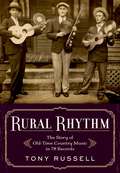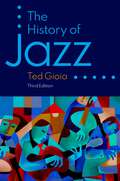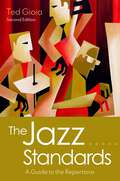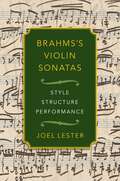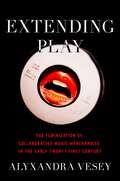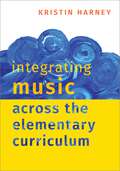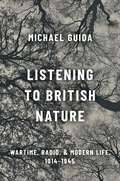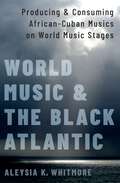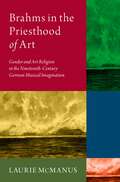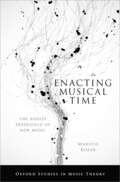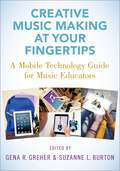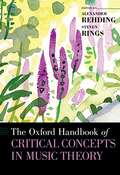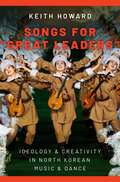- Table View
- List View
Rural Rhythm: The Story of Old-Time Country Music in 78 Records
by Tony RussellThere are many biographies and histories of early country music and its creators, but surprisingly little attention has been given to the actual songs at the heart of these narratives. In this groundbreaking book, music historian Tony Russell turns the spotlight on seventy-eight original 78rpm discs of songs and tunes from the 1920s and 1930s, uncovering the hidden stories of how they came to be recorded, the musicians who sang and played them, the record companies that marketed them, and the listeners who absorbed them. In these essays, based upon new research, contemporary newspaper accounts, and previously unpublished interviews, and copiously illustrated with rare images, readers will find songs about home and family, love and courtship, crime and punishment, farms and floods, chain gangs and chain stores, journeys and memories, and many other aspects of life in the period. Rural Rhythm not only charts the tempos and styles of rural and small-town music-making and the origins of present-day country music, but also traces the larger rhythms of life in the American South, Southwest, and Midwest. What emerges is a narrative that ingeniously blends the musical and social history of the era.
The History of Jazz
by Ted GioiaAn updated new edition of Ted Gioia's universally acclaimed history of jazz, with a wealth of new insight on this music's past, present, and future. Ted Gioia's The History of Jazz has been universally hailed as the most comprehensive and accessible history of the genre of all time. Acclaimed by jazz critics and fans alike, this magnificent work is now available in an up-to-date third edition that covers the latest developments in the jazz world and revisits virtually every aspect of the music. Gioia's story of jazz brilliantly portrays the most legendary jazz players, the breakthrough styles, and the scenes in which they evolved. From Louis Armstrong and Duke Ellington at the Cotton Club, Miles Davis's legendary 1955 performance at the Newport Jazz Festival, and Ornette Coleman's experiments with atonality to current innovators such as Kamasi Washington and Esperanza Spalding, Gioia takes readers on a sweeping journey through the history of jazz. As he traces the music through the swamp lands of the Mississippi Delta, the red light district of New Orleans, the rent parties of Harlem, the speakeasies of Chicago, and other key locales of jazz history, Gioia also makes the social contexts in which the music was born come alive. This new edition finally brings the often overlooked women who shaped the genre into the spotlight and traces the recent developments that have led to an upswing of jazz in contemporary mainstream culture. As it chronicles jazz from its beginnings and most iconic figures to its latest dialogues with popular music, the developments of the digital age, and new commercial successes, Gioia's History of Jazz reasserts its status as the most authoritative survey of this fascinating music.
The History of Jazz
by Ted GioiaAn updated new edition of Ted Gioia's universally acclaimed history of jazz, with a wealth of new insight on this music's past, present, and future. Ted Gioia's The History of Jazz has been universally hailed as the most comprehensive and accessible history of the genre of all time. Acclaimed by jazz critics and fans alike, this magnificent work is now available in an up-to-date third edition that covers the latest developments in the jazz world and revisits virtually every aspect of the music. Gioia's story of jazz brilliantly portrays the most legendary jazz players, the breakthrough styles, and the scenes in which they evolved. From Louis Armstrong and Duke Ellington at the Cotton Club, Miles Davis's legendary 1955 performance at the Newport Jazz Festival, and Ornette Coleman's experiments with atonality to current innovators such as Kamasi Washington and Esperanza Spalding, Gioia takes readers on a sweeping journey through the history of jazz. As he traces the music through the swamp lands of the Mississippi Delta, the red light district of New Orleans, the rent parties of Harlem, the speakeasies of Chicago, and other key locales of jazz history, Gioia also makes the social contexts in which the music was born come alive. This new edition finally brings the often overlooked women who shaped the genre into the spotlight and traces the recent developments that have led to an upswing of jazz in contemporary mainstream culture. As it chronicles jazz from its beginnings and most iconic figures to its latest dialogues with popular music, the developments of the digital age, and new commercial successes, Gioia's History of Jazz reasserts its status as the most authoritative survey of this fascinating music.
The Jazz Standards: A Guide to the Repertoire
by Ted GioiaAn updated new edition of Ted Gioia's acclaimed compendium of jazz standards, featuring 15 additional selections, hundreds of additional recommended tracks, and enhancements and additions on almost every page. Since the first edition of The Jazz Standards was published in 2012, author Ted Gioia has received almost non-stop feedback and suggestions from the passionate global community of jazz enthusiasts and performers requesting crucial additions and corrections to the book. In this second edition, Gioia expands the scope of the book to include more songs, and features new recordings by rising contemporary artists. The Jazz Standards is an essential comprehensive guide to some of the most important jazz compositions, telling the story of more than 250 key jazz songs and providing a listening guide to more than 2,000 recordings. The fan who wants to know more about a tune heard at the club or on the radio will find this book indispensable. Musicians who play these songs night after night will find it to be a handy guide, as it outlines the standards' history and significance and tells how they have been performed by different generations of jazz artists. Students learning about jazz standards will find it to be a go-to reference work for these cornerstones of the repertoire. This book is a unique resource, a browser's companion, and an invaluable introduction to the art form.
The Jazz Standards: A Guide to the Repertoire
by Ted GioiaAn updated new edition of Ted Gioia's acclaimed compendium of jazz standards, featuring 15 additional selections, hundreds of additional recommended tracks, and enhancements and additions on almost every page. Since the first edition of The Jazz Standards was published in 2012, author Ted Gioia has received almost non-stop feedback and suggestions from the passionate global community of jazz enthusiasts and performers requesting crucial additions and corrections to the book. In this second edition, Gioia expands the scope of the book to include more songs, and features new recordings by rising contemporary artists. The Jazz Standards is an essential comprehensive guide to some of the most important jazz compositions, telling the story of more than 250 key jazz songs and providing a listening guide to more than 2,000 recordings. The fan who wants to know more about a tune heard at the club or on the radio will find this book indispensable. Musicians who play these songs night after night will find it to be a handy guide, as it outlines the standards' history and significance and tells how they have been performed by different generations of jazz artists. Students learning about jazz standards will find it to be a go-to reference work for these cornerstones of the repertoire. This book is a unique resource, a browser's companion, and an invaluable introduction to the art form.
Brahms's Violin Sonatas: Style, Structure, Performance
by Joel LesterNotation in Johannes Brahms's sonata scores tells violinists and pianists far more than merely what pitches to play and how long to play them--if read carefully, these scores reveal an immense amount of expression, both of musical and human essences. Joel Lester's Brahms's Violin Sonatas magnifies key passages from these scores, revealing in clear and accessible language how the composer built his themes and musical narratives and how, ultimately, Brahms's music came to sound Brahmsian. Through close readings and annotated musical examples, Brahms's Violin Sonatas guides practitioners to read scores with care and to develop their own informed interpretation of the pieces, eschewing the notion of a single "correct" interpretation of the historical score. By exploring not only the sonatas' musical elements, but also their relationship to important events in the composer's life, Lester shows how subtle components can communicate the gestures, moods, personalities, and emotions that make Brahms's music so compelling. A companion volume to the author's award-winning 1999 study Bach's Works for Solo Violin: Style, Structure, and Performance (OUP), Brahms's Violin Sonatas is a clear and practical guide to understanding and performing Brahms's music in the present.
Brahms's Violin Sonatas: Style, Structure, Performance
by Joel LesterNotation in Johannes Brahms's sonata scores tells violinists and pianists far more than merely what pitches to play and how long to play them--if read carefully, these scores reveal an immense amount of expression, both of musical and human essences. Joel Lester's Brahms's Violin Sonatas magnifies key passages from these scores, revealing in clear and accessible language how the composer built his themes and musical narratives and how, ultimately, Brahms's music came to sound Brahmsian. Through close readings and annotated musical examples, Brahms's Violin Sonatas guides practitioners to read scores with care and to develop their own informed interpretation of the pieces, eschewing the notion of a single "correct" interpretation of the historical score. By exploring not only the sonatas' musical elements, but also their relationship to important events in the composer's life, Lester shows how subtle components can communicate the gestures, moods, personalities, and emotions that make Brahms's music so compelling. A companion volume to the author's award-winning 1999 study Bach's Works for Solo Violin: Style, Structure, and Performance (OUP), Brahms's Violin Sonatas is a clear and practical guide to understanding and performing Brahms's music in the present.
Extending Play: The Feminization of Collaborative Music Merchandise in the Early Twenty-First Century
by Alyxandra VeseyDespite the hypervisibility of a constellation of female pop stars, the music business is structured around gender inequality. As a result, women in the music industry often seize on self-branding opportunities in fashion, cosmetics, food, and technology for the purposes of professional longevity. Extending Play examines the ubiquity of brand partnerships in the contemporary music industry through the lens of feminized labor, to demonstrate how female artists use them as a resource for artistic expression and to articulate forms of popular feminism through self-commodification. In this book, author Alyxandra Vesey examines this type of promotional work and examines its proliferation in the early 21st century. Though brand partnerships exist across all media industries, they are a distinct phenomenon for the music business because of their associations with fan club merchandise, concert merchandise, and lifestyle branding, often foregrounding women's participation in shaping these economies through fan labor and image management. Through textual and discourse analysis of artists' songs, music videos, interviews, social media usage, promotional campaigns, marketing strategies, and business decisions, Extending Play investigates how female musicians co-create branded feminine-coded products like perfume, clothes, makeup, and cookbooks and masculine-coded products like music equipment as resources to work through their own ideas about gender and femininity as workers in industries that often use sexism and ageism to diminish women's creative authority and diminish the value of the recording in order to incentivize musicians to internalize the demands of industrial convergence. By merging star studies, popular music studies, and media industry studies, Extending Play proposes an integrated methodology for approaching contemporary cultural history that demonstrates how female-identified musicians have operated as both a hub for industrial convergence and as music industry professionals who use their extramusical skills to reassert their creative acumen.
Extending Play: The Feminization of Collaborative Music Merchandise in the Early Twenty-First Century
by Alyxandra VeseyDespite the hypervisibility of a constellation of female pop stars, the music business is structured around gender inequality. As a result, women in the music industry often seize on self-branding opportunities in fashion, cosmetics, food, and technology for the purposes of professional longevity. Extending Play examines the ubiquity of brand partnerships in the contemporary music industry through the lens of feminized labor, to demonstrate how female artists use them as a resource for artistic expression and to articulate forms of popular feminism through self-commodification. In this book, author Alyxandra Vesey examines this type of promotional work and examines its proliferation in the early 21st century. Though brand partnerships exist across all media industries, they are a distinct phenomenon for the music business because of their associations with fan club merchandise, concert merchandise, and lifestyle branding, often foregrounding women's participation in shaping these economies through fan labor and image management. Through textual and discourse analysis of artists' songs, music videos, interviews, social media usage, promotional campaigns, marketing strategies, and business decisions, Extending Play investigates how female musicians co-create branded feminine-coded products like perfume, clothes, makeup, and cookbooks and masculine-coded products like music equipment as resources to work through their own ideas about gender and femininity as workers in industries that often use sexism and ageism to diminish women's creative authority and diminish the value of the recording in order to incentivize musicians to internalize the demands of industrial convergence. By merging star studies, popular music studies, and media industry studies, Extending Play proposes an integrated methodology for approaching contemporary cultural history that demonstrates how female-identified musicians have operated as both a hub for industrial convergence and as music industry professionals who use their extramusical skills to reassert their creative acumen.
Integrating Music Across the Elementary Curriculum
by Kristin HarneyThis book is designed to support K-5 classroom teachers as they integrate music throughout the elementary curriculum. It contains detailed, practical ideas and examples, including full lesson plans and over 100 teaching ideas and strategies for integrating music with visual art, language arts, social studies, science, and mathematics. Following an overview of the interdisciplinary approach, the remaining chapters explore connections between music and other areas of the elementary curriculum. Each chapter also includes a section addressing national standards with tables showing the specific standards that are included in each lesson and activity. This text utilizes the most recent National Core Arts Standards (2015) as well as the most recent standards in mathematics, science, social studies, and language arts. All the lessons in this book are designed to be fully taught by classroom teachers; the content is accessible to those who lack formal music training, yet is solidly rooted in research and best practices. While classroom teachers can teach these lessons on their own, this book may facilitate partnerships and collaboration between classroom teachers and music specialists. All the lessons and activities included in this text have been reviewed by practicing teachers and most have been field tested in elementary classrooms. Throughout the book, there is an emphasis on interdisciplinary lessons that demonstrate valid connections between disciplines while maintaining the integrity of each discipline involved, including a teacher-tested model that allows teachers to successfully create their own interdisciplinary lessons.
Integrating Music Across the Elementary Curriculum
by Kristin HarneyThis book is designed to support K-5 classroom teachers as they integrate music throughout the elementary curriculum. It contains detailed, practical ideas and examples, including full lesson plans and over 100 teaching ideas and strategies for integrating music with visual art, language arts, social studies, science, and mathematics. Following an overview of the interdisciplinary approach, the remaining chapters explore connections between music and other areas of the elementary curriculum. Each chapter also includes a section addressing national standards with tables showing the specific standards that are included in each lesson and activity. This text utilizes the most recent National Core Arts Standards (2015) as well as the most recent standards in mathematics, science, social studies, and language arts. All the lessons in this book are designed to be fully taught by classroom teachers; the content is accessible to those who lack formal music training, yet is solidly rooted in research and best practices. While classroom teachers can teach these lessons on their own, this book may facilitate partnerships and collaboration between classroom teachers and music specialists. All the lessons and activities included in this text have been reviewed by practicing teachers and most have been field tested in elementary classrooms. Throughout the book, there is an emphasis on interdisciplinary lessons that demonstrate valid connections between disciplines while maintaining the integrity of each discipline involved, including a teacher-tested model that allows teachers to successfully create their own interdisciplinary lessons.
Listening to British Nature: Wartime, Radio, and Modern Life, 1914-1945
by Michael GuidaListening to British Nature: Wartime, Radio, and Modern Life, 1914-1945 reveals for the first time how the sounds and rhythms of the natural world were listened to, interpreted and used amid the pressures of early twentieth century life. The book argues that despite and sometimes because of the chaos of wartime and the struggle to recover, nature's voices were drawn close to provide security and engender optimism. Nature's sonic presences were not obliterated by machine age noise, the advent of radio broadcasting or the rush of the urban everyday, rather they came to complement and provide alternatives to modern modes of living. This book examines how trench warfare demanded the creation of new listening cultures to understand danger and to imagine survival. It tells of the therapeutic communities who made use of nature's quietude and the rhythms of rural work to restore shell-shocked soldiers, and of ramblers who sought to immerse themselves in the sensualities of the outdoors. It reveals how home-front listening during the Blitz was punctuated by birdsong, broadcast by the BBC. To listen to nature during this period was to cultivate an intimate connection with its energies and to sense an enduring order and beauty that could be taken into the future. Listening to nature was a way of being modern.
Listening to British Nature: Wartime, Radio, and Modern Life, 1914-1945
by Michael GuidaListening to British Nature: Wartime, Radio, and Modern Life, 1914-1945 reveals for the first time how the sounds and rhythms of the natural world were listened to, interpreted and used amid the pressures of early twentieth century life. The book argues that despite and sometimes because of the chaos of wartime and the struggle to recover, nature's voices were drawn close to provide security and engender optimism. Nature's sonic presences were not obliterated by machine age noise, the advent of radio broadcasting or the rush of the urban everyday, rather they came to complement and provide alternatives to modern modes of living. This book examines how trench warfare demanded the creation of new listening cultures to understand danger and to imagine survival. It tells of the therapeutic communities who made use of nature's quietude and the rhythms of rural work to restore shell-shocked soldiers, and of ramblers who sought to immerse themselves in the sensualities of the outdoors. It reveals how home-front listening during the Blitz was punctuated by birdsong, broadcast by the BBC. To listen to nature during this period was to cultivate an intimate connection with its energies and to sense an enduring order and beauty that could be taken into the future. Listening to nature was a way of being modern.
Journeys Through Galant Expositions
by L. Poundie BursteinEver since the nineteenth century, descriptions of musical form have tended to rely heavily on architectonic analogies. In contrast, earlier discussions more often invoked the metaphor of a journey to describe the structure of a composition. In Journeys Through Galant Expositions, author L. Poundie Burstein encourages readers to view the form of Galant music through this earlier metaphorical lens, much as those who composed, performed, improvised, and listened to music in the mid-1700s would have experienced it. By elucidating eighteenth-century ideas regarding musical form and applying them to works by a wide range of composers including Haydn and Mozart, as well as a host of others who are often overlooked this innovative study provides an accessible new window into the music of this time. Rather than dissecting concepts from the 1700s as a mere historical exercise or treating them as a precursor of later theories, Burstein invigorates the ideas of theorists such as Heinrich Christoph Koch and shows how they can directly impact our understanding and appreciation of Galant music as audiences and performers.
Journeys Through Galant Expositions
by L. Poundie BursteinEver since the nineteenth century, descriptions of musical form have tended to rely heavily on architectonic analogies. In contrast, earlier discussions more often invoked the metaphor of a journey to describe the structure of a composition. In Journeys Through Galant Expositions, author L. Poundie Burstein encourages readers to view the form of Galant music through this earlier metaphorical lens, much as those who composed, performed, improvised, and listened to music in the mid-1700s would have experienced it. By elucidating eighteenth-century ideas regarding musical form and applying them to works by a wide range of composers including Haydn and Mozart, as well as a host of others who are often overlooked this innovative study provides an accessible new window into the music of this time. Rather than dissecting concepts from the 1700s as a mere historical exercise or treating them as a precursor of later theories, Burstein invigorates the ideas of theorists such as Heinrich Christoph Koch and shows how they can directly impact our understanding and appreciation of Galant music as audiences and performers.
WORLD MUSIC & THE BLACK ATLANTIC C: Producing and Consuming African-Cuban Musics on World Music Stages
by Aleysia K. WhitmoreIn the mid-20th century, African musicians took up Cuban music as their own and claimed it as a marker of black Atlantic connections and of cosmopolitanism untethered from European colonial relations. Today, Cuban/African bands popular in Africa in the 1960s and '70s have moved into the world music scene in Europe and North America, and world music producers and musicians have created new West African-Latin American collaborations expressly for this market niche. World Music and the Black Atlantic follows two of these bands, Orchestra Baobab and AfroCubism, and the industry and audiences that surround them-from musicians' homes in West Africa, to performances in Europe and North America, to record label offices in London. World Music and the Black Atlantic examines the intensely transnational experiences of musicians, industry personnel, and audiences as they collaboratively produce, circulate, and consume music in a specific post-colonial era of globalization. Musicians, industry personnel, and audiences work with and push against one another as they engage in personal collaborations imbued with histories of global travel and trade. They move between and combine Cuban and Malian melodies, Norwegian and Senegalese markets, and histories of slavery and independence as they work together to create international commodities. Understanding the unstable and dynamic ways these peoples, musics, markets, and histories intersect elucidates how world music actors assert their places within, and produce knowledge about, global markets, colonial histories, and the black Atlantic. World Music and the Black Atlantic offers a nuanced view of a global industry that is informed and deeply marked by diverse transnational perspectives and histories of transatlantic exchange.
World Music and the Black Atlantic: Producing and Consuming African-Cuban Musics on World Music Stages
by Aleysia K. WhitmoreIn the mid-20th century, African musicians took up Cuban music as their own and claimed it as a marker of black Atlantic connections and of cosmopolitanism untethered from European colonial relations. Today, Cuban/African bands popular in Africa in the 1960s and '70s have moved into the world music scene in Europe and North America, and world music producers and musicians have created new West African-Latin American collaborations expressly for this market niche. World Music and the Black Atlantic follows two of these bands, Orchestra Baobab and AfroCubism, and the industry and audiences that surround them-from musicians' homes in West Africa, to performances in Europe and North America, to record label offices in London. World Music and the Black Atlantic examines the intensely transnational experiences of musicians, industry personnel, and audiences as they collaboratively produce, circulate, and consume music in a specific post-colonial era of globalization. Musicians, industry personnel, and audiences work with and push against one another as they engage in personal collaborations imbued with histories of global travel and trade. They move between and combine Cuban and Malian melodies, Norwegian and Senegalese markets, and histories of slavery and independence as they work together to create international commodities. Understanding the unstable and dynamic ways these peoples, musics, markets, and histories intersect elucidates how world music actors assert their places within, and produce knowledge about, global markets, colonial histories, and the black Atlantic. World Music and the Black Atlantic offers a nuanced view of a global industry that is informed and deeply marked by diverse transnational perspectives and histories of transatlantic exchange.
Brahms in the Priesthood of Art: Gender and Art Religion in the Nineteenth-Century German Musical Imagination
by Laurie McManusBrahms in the Priesthood of Art: Gender and Art Religion in the Nineteenth-Century German Musical Imagination explores the intersection of gender, art religion (Kunstreligion) and other aesthetic currents in Brahms reception of the nineteenth and early twentieth centuries. In particular, it focuses on the theme of the self-sacrificing musician devoted to his art, or "priest of music," with its quasi-mystical and German Romantic implications of purity seemingly at odds with the lived reality of Brahms's bourgeois existence. While such German Romantic notions of art religion informed the thinking on musical purity and performance, after the failed socio-political revolutions of 1848/49, and in the face of scientific developments, the very concept of musical priesthood was questioned as outmoded. Furthermore, its essential gender ambiguity, accommodating such performing mothers as Clara Schumann and Amalie Joachim, could suit the bachelor Brahms but leave the composer open to speculation. Supportive critics combined elements of masculine and feminine values with a muddled rhetoric of prophets, messiahs, martyrs, and other art-religious stereotypes to account for the special status of Brahms and his circle. Detractors tended to locate these stereotypes in a more modern, fin-de-siècle psychological framework that questioned the composer's physical and mental well-being. In analyzing these receptions side by side, this book revises the accepted image of Brahms, recovering lost ambiguities in his reception. It resituates him not only in a romanticized priesthood of art, but also within the cultural and gendered discourses overlooked by the absolute music paradigm.
Brahms in the Priesthood of Art: Gender and Art Religion in the Nineteenth-Century German Musical Imagination
by Laurie McManusBrahms in the Priesthood of Art: Gender and Art Religion in the Nineteenth-Century German Musical Imagination explores the intersection of gender, art religion (Kunstreligion) and other aesthetic currents in Brahms reception of the nineteenth and early twentieth centuries. In particular, it focuses on the theme of the self-sacrificing musician devoted to his art, or "priest of music," with its quasi-mystical and German Romantic implications of purity seemingly at odds with the lived reality of Brahms's bourgeois existence. While such German Romantic notions of art religion informed the thinking on musical purity and performance, after the failed socio-political revolutions of 1848/49, and in the face of scientific developments, the very concept of musical priesthood was questioned as outmoded. Furthermore, its essential gender ambiguity, accommodating such performing mothers as Clara Schumann and Amalie Joachim, could suit the bachelor Brahms but leave the composer open to speculation. Supportive critics combined elements of masculine and feminine values with a muddled rhetoric of prophets, messiahs, martyrs, and other art-religious stereotypes to account for the special status of Brahms and his circle. Detractors tended to locate these stereotypes in a more modern, fin-de-siècle psychological framework that questioned the composer's physical and mental well-being. In analyzing these receptions side by side, this book revises the accepted image of Brahms, recovering lost ambiguities in his reception. It resituates him not only in a romanticized priesthood of art, but also within the cultural and gendered discourses overlooked by the absolute music paradigm.
Enacting Musical Time: The Bodily Experience of New Music (Oxford Studies in Music Theory)
by Mariusz KozakWhat is musical time? Where is it manifested? How does it enter into our experience, and how do we capture it in our analyses? A compelling approach among works on temporality, phenomenology, and the ecologies of the new sound worlds, Enacting Musical Time argues that musical time is itself the site of the interaction between musical sounds and a situated, embodied listener, created by the moving bodies of participants engaged in musical activities. Author Mariusz Kozak describes musical time as something that emerges when the listener enacts her implicit knowledge about "how music goes," from deliberate inactivity, to such simple actions as tapping her foot in time with the beat, to dancing in a way that engages her entire body. Kozak explores this idea in the context of modernist and postmodernist musical styles, where composers create unfamiliar and idiosyncratic temporal experiences, blur the line between spectatorship and participation, and challenge conventional notions of form. Basing his discussion on the phenomenology of Merleau-Ponty and on the ecological psychology of J. J. Gibson, Kozak examines different aspects of musical structure through the lens of embodied cognition and what phenomenologists call "lived time." A bold new theory derived from an unprecedented fusion of research perspectives, Enacting Musical Time will engage scholars across a range of disciplines, from music theory, music cognition, cognitive science, continental philosophy, and social anthropology.
Enacting Musical Time: The Bodily Experience of New Music (Oxford Studies in Music Theory)
by Mariusz KozakWhat is musical time? Where is it manifested? How does it enter into our experience, and how do we capture it in our analyses? A compelling approach among works on temporality, phenomenology, and the ecologies of the new sound worlds, Enacting Musical Time argues that musical time is itself the site of the interaction between musical sounds and a situated, embodied listener, created by the moving bodies of participants engaged in musical activities. Author Mariusz Kozak describes musical time as something that emerges when the listener enacts her implicit knowledge about "how music goes," from deliberate inactivity, to such simple actions as tapping her foot in time with the beat, to dancing in a way that engages her entire body. Kozak explores this idea in the context of modernist and postmodernist musical styles, where composers create unfamiliar and idiosyncratic temporal experiences, blur the line between spectatorship and participation, and challenge conventional notions of form. Basing his discussion on the phenomenology of Merleau-Ponty and on the ecological psychology of J. J. Gibson, Kozak examines different aspects of musical structure through the lens of embodied cognition and what phenomenologists call "lived time." A bold new theory derived from an unprecedented fusion of research perspectives, Enacting Musical Time will engage scholars across a range of disciplines, from music theory, music cognition, cognitive science, continental philosophy, and social anthropology.
CREAT MUSIC MAKING AT YOUR FINGERTIPS C: A Mobile Technology Guide for Music Educators
by Gena R. Greher, Suzanne L. BurtonStudents are drawn to mobile technologies such as iPads and smartphones because of the sheer endless possibilities of the digital worlds they hold. But how can their potential for stimulating the imagination be effectively used in the music classroom to support students' development of musical thinking? Countering voices that see digital technologies as a threat to traditional forms of music making and music education, this collection explores the many ways in which hand-held devices can be used to promote student learning and provides teachers with guidance on making them a vital presence in their own classrooms. Creative Music Making at Your Fingertips features 11 chapters by music education scholars and practitioners that provide tried-and-true strategies for using mobile devices in a variety of contexts, from general music education to ensembles and from K-12 to college classrooms. Drawing on their own experiences with bringing mobile devices and different music apps into the classroom, contributors show how these technologies can be turned into tools for teaching performance, improvisation, and composition. Their practical advice on how pedagogy and mobile technologies can be aligned to increase students' creative engagement with music and help them realize their musical potential makes this book an invaluable resource for music educators who want to be at the forefront of pedagogical transformations made possible by 21st-century technologies.
Creative Music Making at Your Fingertips: A Mobile Technology Guide for Music Educators
Students are drawn to mobile technologies such as iPads and smartphones because of the sheer endless possibilities of the digital worlds they hold. But how can their potential for stimulating the imagination be effectively used in the music classroom to support students' development of musical thinking? Countering voices that see digital technologies as a threat to traditional forms of music making and music education, this collection explores the many ways in which hand-held devices can be used to promote student learning and provides teachers with guidance on making them a vital presence in their own classrooms. Creative Music Making at Your Fingertips features 11 chapters by music education scholars and practitioners that provide tried-and-true strategies for using mobile devices in a variety of contexts, from general music education to ensembles and from K-12 to college classrooms. Drawing on their own experiences with bringing mobile devices and different music apps into the classroom, contributors show how these technologies can be turned into tools for teaching performance, improvisation, and composition. Their practical advice on how pedagogy and mobile technologies can be aligned to increase students' creative engagement with music and help them realize their musical potential makes this book an invaluable resource for music educators who want to be at the forefront of pedagogical transformations made possible by 21st-century technologies.
The Oxford Handbook of Critical Concepts in Music Theory (Oxford Handbooks)
by Alexander Rehding and Steven RingsMusic Theory has a lot of ground to cover. Especially in introductory classes a whole range of fundamental concepts are introduced at fast pace that can never be explored in depth or detail, as other new topics become more pressing. The short time we spend with them in the classroom belies the complexity (and, in many cases, the contradictions) underlying these concepts. This book takes the time to tarry over these complexities, probe the philosophical assumptions on which these concepts rest, and shine a light on all their iridescent facets. This book presents music-theoretical concepts as a register of key terms progressing outwards from smallest detail to discussions of the music-theoretical project on the largest scale. The approaches individual authors take range from philosophical, historical, or analytical to systematic, cognitive, and critical-theorical-covering the whole diverse spectrum of contemporary music theory. In some cases authors explore concepts that have not yet been widely added to the theorist's toolkit but deserve to be included; in other cases concepts are expanded beyond their core repertory of application. This collection does not shy away from controversy. Taken in their entirety, the essays underline that music theory is on the move, exploring new questions, new repertories, and new approaches. This collection is an invitation to take stock of music theory in the early twenty-first century, to look back and to encourage discussion about its future directions. Its chapters open up a panoramic view of the contemporary music-theoretical landscape with its expanding repertories and changing guiding questions, and offers suggestions as to where music theory is headed in years to come.
Songs for "Great Leaders": Ideology and Creativity in North Korean Music and Dance
by Keith HowardFamously reclusive and secretive, North Korea can be seen as a theatre that projects itself through music and performance. The first book-length account of North Korean music and dance in any language other than Korean, Songs for "Great Leaders" pulls back the curtain on this theatre for the first time. Renowned ethnomusicologist Keith Howard moves from the first songs written in the northern part of the divided Korean peninsula in 1946 to the performances in February 2018 by a North Korean troupe visiting South Korea for the Pyeongchang Winter Olympic Games. Through an exceptionally wide range of sources and a perspective of deep cultural competence, Howard explores old revolutionary songs and new pop songs, developments of Korean instruments, the creation of revolutionary operas, and mass spectacles, as well as dance and dance notation, and composers and compositions. The result is a nuanced and detailed account of how song, together with other music and dance production, forms the soundtrack to the theater of daily life, embedding messages that tell the official history, the exploits of leaders, and the socialist utopia yet-to-come. Based on fieldwork, interviews, and resources in private and public archives and libraries in North Korea, South Korea, China, North America and Europe, Songs for "Great Leaders" opens up the North Korean regime in a way never before attempted or possible.
